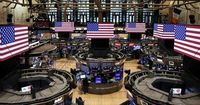Wall Street’s rally, which has captivated investors for months, hit the brakes on Thursday, October 9, 2025, as U.S. stocks retreated from their record highs and market participants paused to catch their breath. The S&P 500, which has soared nearly 90% since the current bull market began in October 2022, slipped 0.3%—its second loss in the last ten days—falling 18.61 points to 6,735.11. The Dow Jones Industrial Average fared worse, dropping 243.36 points, or 0.52%, to close at 46,358.42. The Nasdaq composite edged down by 0.1%, losing 18.75 points to finish at 23,024.63, according to the Associated Press and Reuters.
These losses arrived after a period of relentless gains, fueled in large part by the ongoing boom in artificial intelligence technology. The surge has been so pronounced that some market watchers have begun to worry about valuations becoming stretched, particularly among tech and AI-related stocks. As Reuters reported, the pause came as investors, left with scant economic data due to the ongoing government shutdown, chose to consolidate ahead of the third-quarter earnings season.
"The earnings cycle is upon us and there's a wait-and-see in terms of whether we’ll see the same level of consistency of earnings growth in the coming quarter that we've seen in the last two quarters," said Matthew Keator, managing partner at the Keator Group, in an interview with Reuters. He added, "Couple that with the uncertainty surrounding the lack of data coming out of Washington and how the Fed navigates that, it's natural to see a bit of a pullback."
The government shutdown, now in its ninth day, has deprived investors of key economic indicators, including the weekly unemployment claims report, which typically guides Thursday trading. This lack of official data has made the market more sensitive to company earnings and statements from Federal Reserve officials. Market participants have been forced to look elsewhere for clues about the economy’s health and the path of interest rates.
Against this backdrop, the Federal Reserve’s policy direction remains a focal point. Financial markets are currently pricing in a 94.6% chance that the Fed will implement a 25 basis-point interest rate cut at its upcoming October 28-29 meeting, according to CME’s FedWatch tool cited by Reuters. New York Federal Reserve President John Williams, in an interview with The New York Times published Thursday, expressed his support for more interest rate reductions before the end of the year due to risks facing the weakening labor market.
Tally Leger, chief market strategist at The Wealth Consulting Group, struck an optimistic tone about the future of stocks, telling Reuters, “The Federal Reserve, our central bank, has resumed its interest rate cuts into an economy that has been surprising many observers with its resilience, even strength. And you can include to that the robust pace of corporate profits.” Leger added, “With the current mania in artificial intelligence and business investment in technology, including AI, we think that this bull run has quarters, if not years, more to run.”
Still, Thursday’s session was marked by a handful of notable movers. Dell Technologies tumbled 5.2%—the largest drop in the S&P 500 that day—after a week in which it had surged nearly 11% on the back of bullish AI growth projections. Despite the pullback, Dell remained up for the week, highlighting the volatility surrounding AI-driven stocks. Tesla also weighed on the broader market, sliding 0.7% after the National Highway Traffic Safety Administration opened a preliminary evaluation of its “Full Self-Driving” system over safety concerns.
On the positive side of the ledger, Delta Air Lines soared 4.3% after reporting stronger-than-expected profits for the summer and providing an upbeat forecast for the remainder of the year. Delta’s president, Glen Hauenstein, pointed to a “broad-based acceleration in sales trends over the last six weeks, including for business travel domestically,” according to the AP. The airline’s performance also helped lift the S&P 1500 Airlines index by 1.9%, with other U.S. carriers joining the rally.
Costco Wholesale was another bright spot, climbing 3.1% after the retailer reported an 8% jump in September revenue compared to a year earlier. The company’s strong results offered a reassuring signal about consumer spending, even as broader economic data remain out of reach due to the government shutdown.
Elsewhere, PepsiCo rose 4.2% after delivering a better-than-expected profit for the latest quarter and reporting improved momentum in its North American drinks business. Akero Therapeutics leaped 16.3% after Novo Nordisk, the Danish pharmaceutical giant behind the weight-loss drug Wegovy, announced plans to acquire the company for up to $5.2 billion, contingent on regulatory approval. MP Materials, which mines and processes rare earths in California, gained 2.4% following news that China would impose new export curbs on these critical materials. Albemarle, a lithium producer, advanced 5.3% after a price target hike from brokerage TD Cowen and amid the same rare earth export concerns.
Gold, which had been on a stellar rally throughout the year, also pulled back, falling 2.4% to drop below $4,000 per ounce. The yield on the 10-year Treasury note held relatively steady, edging up to 4.14% from 4.13% the previous day, as reported by the AP.
Internationally, market moves were mixed. In Europe, Italy’s Ferrari plunged 15.4% after releasing financial forecasts that fell short of analysts’ expectations. In Asia, Shanghai’s stock index rose 1.3% as trading resumed after a holiday, and Japan’s Nikkei 225 jumped 1.8%, buoyed by an 11.4% surge in SoftBank Group shares following its $5.4 billion acquisition of ABB’s robotics unit.
Despite Thursday’s setback, the broader context remains one of remarkable gains. Sunday, October 12, will mark the third anniversary of the current bull market, which began after the S&P 500 hit its cycle low in October 2022 in the wake of Federal Reserve monetary tightening. Since then, tech and AI-adjacent megastocks have been the primary engines of growth. Analysts, however, expect S&P 500 earnings growth to moderate, projecting an 8.8% year-on-year rise for the July-September period—down from 13.8% in the prior quarter, according to LSEG data cited by Reuters.
Trading volume on U.S. exchanges was robust, totaling 20.44 billion shares, compared to the 19.75 billion average over the previous 20 trading days. But declining issues outnumbered advancers by nearly three-to-one on the New York Stock Exchange, a sign that the day’s pullback was broad-based.
As the third-quarter earnings season approaches and the government shutdown drags on, investors remain in a holding pattern, searching for the next catalyst. Whether the bull market’s extraordinary run can continue will depend on a combination of corporate results, Federal Reserve policy, and—eventually—the return of reliable economic data.
For now, Wall Street has hit the pause button, but with AI fueling both excitement and anxiety, the next chapter in this market’s story promises to be anything but dull.






